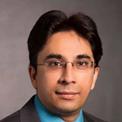Mudasir Ahmad
Email: mudasirahmad@gmail.com
Topics: Internet of Things (IoT), Advanced Packaging, 2.5D, Heterogeneous Silicon Photonics, Advanced Reliability (Thermomechanical, Mechanical Shock), Numerical Modeling, Advanced Thermal Solutions, Stochastic Analysis, Bayesian Inference, Machine Learning, Artificial Intelligence

Mudasir Ahmad is the group manager of the System Reliability and Adv. Numerical Analysis Teams in the Global Hardware Quality and Reliability (GHQR) Organization in Google Technical Infrastructure (TI). Mudasir’s teams are responsible for system level hardware reliability of critical hardware deployed in all Google Data Centers. Before Google, he was a Distinguished Engineer/Senior Director at Cisco Systems, Inc. He has been involved with mechanical design, microelectronics packaging design and reliability analysis for more than 20 years. Mudasir is involved in developing new analytical/stochastic algorithms, experimental design, thermal and reliability characterization of next generation 3D packaging, System-in-Package Modules, Chiplets and Silicon Photonics. Mudasir was also involved with implementing IoT, Artificial Intelligence and Big Data Analytics to streamline Supply Chain Operations. Mudasir has delivered several invited talks on leading technology solutions internationally.
Outside of Google, he is a Distinguished Lecturer of the Electronics Packaging Society of the IEEE (EPS) and participates in standards organizations and consortia such as IPC, JEDEC and ODSA. He was actively involved in the local EPS chapter of IEEE for several years; holding the positions of Secretary, Vice Chair and Chair of the Chapter.
He received the internationally renowned Outstanding Young Engineer Award in 2012 from the IEEE. He received his M.S. in Management Science & Engineering at Stanford University, his M.S. degree in Mechanical Engineering from Georgia Institute of Technology and his B.S. from Ohio University. Mudasir has over 30 publications on microelectronic packaging, two book chapters, and 17 US Patents.

